|
|

|
|
Author
|
Topic: NASA's Phoenix mission to Mars (2008)
|
Robert Pearlman
Editor Posts: 42988
From: Houston, TX
Registered: Nov 1999
|
 posted 10-29-2008 09:34 PM
posted 10-29-2008 09:34 PM
   
Phoenix Mission Status Report NASA's Phoenix Mars Lander entered safe mode late yesterday in response to a low-power fault brought on by deteriorating weather conditions. While engineers anticipated that a fault could occur due to the diminishing power supply, the lander also unexpectedly switched to the "B" side of its redundant electronics and shut down one of its two batteries. During safe mode, the lander stops non-critical activities and awaits further instructions from the mission team. Within hours of receiving information of the safing event, mission engineers at NASA's Jet Propulsion Laboratory, Pasadena, Calif., and at Lockheed Martin in Denver, were able to send commands to restart battery charging. It is not likely that any energy was lost. Weather conditions at the landing site in the north polar region of Mars have deteriorated in recent days, with overnight temperatures falling to -141F (-96C), and daytime temperatures only as high as -50F (-45C), the lowest temperatures experienced so far in the mission. A mild dust storm blowing through the area, along with water-ice clouds, further complicated the situation by reducing the amount of sunlight reaching the lander's solar arrays, thereby reducing the amount of power it could generate. Low temperatures caused the lander's battery heaters to turn on Tuesday for the first time, creating another drain on precious power supplies. Science activities will remain on hold for the next several days to allow the spacecraft to recharge and conserve power. Attempts to resume normal operations will not take place before the weekend. "This is a precarious time for Phoenix," said Phoenix Project Manager Barry Goldstein of JPL. "We're in the bonus round of the extended mission, and we're aware that the end could come at any time. The engineering team is doing all it can to keep the spacecraft alive and collecting science, but at this point survivability depends on some factors out of our control, such as the weather and temperatures on Mars." The ability to communicate with the spacecraft has not been impacted. However, the team decided to cancel communication sessions Wednesday morning in order to conserve spacecraft power. The next communication pass is anticipated at 9:30 p.m. PDT Wednesday. Yesterday, the mission announced plans to turn off four heaters, one at a time, in an effort to preserve power. The faults experienced late Tuesday prompted engineers to command the lander to shut down two heaters instead of one as originally planned. One of those heaters warmed electronics for Phoenix's robotic arm, robotic-arm camera, and thermal and evolved-gas analyzer (TEGA), an instrument that bakes and sniffs Martian soil to assess volatile ingredients. The second heater served the lander's pyrotechnic initiation unit, which hasn't been used since landing. By turning off selected heaters, the mission hopes to preserve power and prolong the use of the lander's camera and meteorological instruments. Originally scheduled to last 90 days, Phoenix has completed a fifth month of exploration in the Martian arctic. As the Martian northern hemisphere shifts from summer to autumn, the lander was expected to generate less power due to fewer hours of sunlight reaching its solar panels. "It could be a matter of days, or weeks, before the daily power generated by Phoenix is less than needed to operate the spacecraft," said JPL mission manager Chris Lewicki. "We have only a few options left to reduce the energy usage."
|
Robert Pearlman
Editor Posts: 42988
From: Houston, TX
Registered: Nov 1999
|
 posted 10-30-2008 10:05 PM
posted 10-30-2008 10:05 PM
   
Phoenix Mission Status Report NASA's Phoenix Mars Lander, with its solar-electric power shrinking due to shorter daylight hours and a dust storm, did not respond to an orbiter's attempt to communicate with it Wednesday night and Thursday morning.  Mission controllers judge the most likely situation to be that declining power has triggered a pre-set precautionary behavior of waking up for only about two hours per day to listen for an orbiter's hailing signal. If that is the case, the wake-sleep cycling would have begun at an unknown time when batteries became depleted. "We will be coordinating with the orbiter teams to hail Phoenix as often as feasible to catch the time when it can respond," said Phoenix Project Manager Barry Goldstein at NASA's Jet Propulsion Laboratory, Pasadena, Calif. "If we can reestablish communication, we can begin to get the spacecraft back in condition to resume science. In the best case, if weather cooperates, that would take the better part of a week." The Phoenix lander has operated at a Martian arctic site for more than two months longer than its initially planned, three-month prime mission. The sun stayed above the horizon around the clock during the prime mission, but is now below the horizon for about 7 hours each night.
UPDATE! at 4 p.m. PDT October 30: Phoenix communicated with NASA's Mars Odyssey orbiter Thursday. The communication reinforced a diagnosis that the spacecraft is in a precautionary mode triggered by low energy. Mission engineers are assessing the lander's condition and steps necessary for returning to science operations.
|
Robert Pearlman
Editor Posts: 42988
From: Houston, TX
Registered: Nov 1999
|
 posted 11-03-2008 10:14 PM
posted 11-03-2008 10:14 PM
   
NASA release NASA Hearing Daily From Weak Phoenix Mars LanderNASA's Phoenix Mars Lander has communicated with controllers daily since Oct. 30 through relays to Mars orbiters. Information received over the weekend indicates Phoenix is running out of power each afternoon or evening but reawakening after its solar arrays catch morning sunlight. The fraction of each day with sun above the horizon is declining at the Martian arctic landing site. Dust raised by a storm last week continues to block some of the sunshine. "This is exactly the scenario we expected for the mission's final phase, though the dust storm brought it a couple weeks sooner than we had hoped," said Phoenix Project Manager Barry Goldstein of NASA's Jet Propulsion Laboratory, Pasadena, Calif. "We will be trying to gain some additional science during however many days we have left. Any day could be our last." Mission engineers at JPL and at Lockheed Martin Space Systems, Denver, are attempting this week to upload commands to be stored in the lander's flash memory for science activities to be conducted when the lander wakes up each day. "Weather observations are our top priority now," said Phoenix Principal Investigator Peter Smith. "If there's enough energy, we will try to get readings from the conductivity probe that has been inserted into the soil, and possibly some images to assess frost buildup." Phoenix landed on Mars May 25. It accomplished its main science goals during the three months originally planned as its prime mission, then continued operating, now in its sixth month. |
Robert Pearlman
Editor Posts: 42988
From: Houston, TX
Registered: Nov 1999
|
 posted 11-10-2008 02:34 PM
posted 11-10-2008 02:34 PM
   
NASA's Phoenix Mars Lander has come to its end. Mission engineers stopped receiving signals from the lander and believe its batteries have been depleted. In recent weeks, the spacecraft faced shorter periods of daylight, dustier skies, and colder temperature that caused power supplies to diminish. Eventually, the amount of energy needed to operate the spacecraft exceeded the amount it could generate. Phoenix exceeded its planned operational life of 90 days, returning scientific data for more than five months.  |
Robert Pearlman
Editor Posts: 42988
From: Houston, TX
Registered: Nov 1999
|
 posted 11-10-2008 03:21 PM
posted 11-10-2008 03:21 PM
   
NASA release Mars Phoenix Lander Finishes Successful Work on Red PlanetNASA's Phoenix Mars Lander has ceased communications after operating for more than five months. As anticipated, seasonal decline in sunshine at the robot's arctic landing site is not providing enough sunlight for the solar arrays to collect the power necessary to charge batteries that operate the lander's instruments. 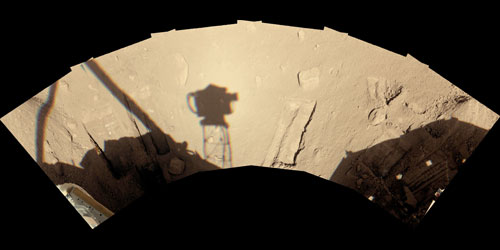 Mission engineers last received a signal from the lander on Nov. 2. Phoenix, in addition to shorter daylight, has encountered a dustier sky, more clouds and colder temperatures as the northern Mars summer approaches autumn. The mission exceeded its planned operational life of three months to conduct and return science data. The project team will be listening carefully during the next few weeks to hear if Phoenix revives and phones home. However, engineers now believe that is unlikely because of the worsening weather conditions on Mars. While the spacecraft's work has ended, the analysis of data from the instruments is in its earliest stages. "Phoenix has given us some surprises, and I'm confident we will be pulling more gems from this trove of data for years to come," said Phoenix Principal Investigator Peter Smith of the University of Arizona in Tucson. Launched Aug. 4, 2007, Phoenix landed May 25, 2008, farther north than any previous spacecraft to land on the Martian surface. The lander dug, scooped, baked, sniffed and tasted the Red Planet's soil. Among early results, it verified the presence of water-ice in the Martian subsurface, which NASA's Mars Odyssey orbiter first detected remotely in 2002. Phoenix's cameras also returned more than 25,000 pictures from sweeping vistas to near the atomic level using the first atomic force microscope ever used outside Earth. "Phoenix not only met the tremendous challenge of landing safely, it accomplished scientific investigations on 149 of its 152 Martian days as a result of dedicated work by a talented team," said Phoenix Project Manager Barry Goldstein at NASA's Jet Propulsion Laboratory in Pasadena, Calif. Phoenix's preliminary science accomplishments advance the goal of studying whether the Martian arctic environment has ever been favorable for microbes. Additional findings include documenting a mildly alkaline soil environment unlike any found by earlier Mars missions; finding small concentrations of salts that could be nutrients for life; discovering perchlorate salt, which has implications for ice and soil properties; and finding calcium carbonate, a marker of effects of liquid water. Phoenix findings also support the goal of learning the history of water on Mars. These findings include excavating soil above the ice table, revealing at least two distinct types of ice deposits; observing snow descending from clouds; providing a mission-long weather record, with data on temperature, pressure, humidity and wind; observations of haze, clouds, frost and whirlwinds; and coordinating with NASA's Mars Reconnaissance Orbiter to perform simultaneous ground and orbital observations of Martian weather. "Phoenix provided an important step to spur the hope that we can show Mars was once habitable and possibly supported life," said Doug McCuistion, director of the Mars Exploration Program at NASA Headquarters in Washington. "Phoenix was supported by orbiting NASA spacecraft providing communications relay while producing their own fascinating science. With the upcoming launch of the Mars Science Laboratory, the Mars Program never sleeps." The University of Arizona leads the Phoenix mission with project management at JPL and development partnership at Lockheed Martin Corporation in Denver. International contributions came from the Canadian Space Agency; the University of Neuchatel, Switzerland; the universities of Copenhagen and Aarhus in Denmark; the Max Planck Institute in Germany; the Finnish Meteorological Institute; and Imperial College of London. 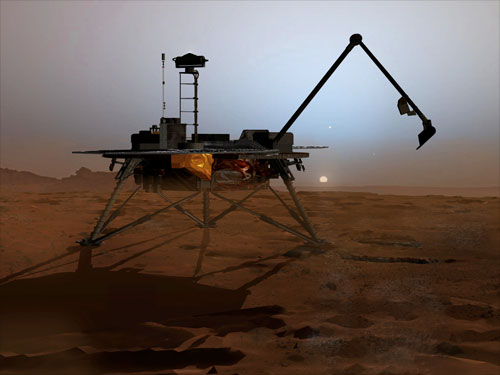 |
Robert Pearlman
Editor Posts: 42988
From: Houston, TX
Registered: Nov 1999
|
 posted 11-04-2009 09:52 PM
posted 11-04-2009 09:52 PM
   
NASA release Frost-Covered Phoenix Lander Seen in Winter ImagesWinter images of NASA's Phoenix Lander showing the lander shrouded in dry-ice frost on Mars have been captured with the High Resolution Imaging Science Experiment, or HiRISE camera, aboard NASA's Mars Reconnaissance Orbiter. The HiRISE camera team at the University of Arizona, Tucson, captured one image of the Phoenix lander on July 30, 2009, and the other on Aug. 22, 2009. That's when the sun began peeking over the horizon of the northern polar plains during winter, the imaging team said. The first day of spring in the northern hemisphere began Oct. 26. "We decided to try imaging the site despite the low light levels," said HiRISE team member Ingrid Spitale of the University of Arizona Lunar and Planetary Laboratory. "The power of the HiRISE camera helped us see it even under these poor light conditions," added HiRISE team member Michael Mellon of the University of Colorado in Boulder, who was also on the Phoenix Mars Lander science team. The HiRISE team targeted their camera at the known location of the lander to get the new images and compared them to a HiRISE image of the frost-free lander taken in June 2008. That enabled them to identify the hardware disguised by frost, despite the fact that their views were hindered by poor lighting and by atmospheric haze, which often obscures the surface at this location and season. Carbon dioxide frost completely blankets the surface in both images. The amount of carbon dioxide frost builds as late winter transitions to early spring, so the layer of frost is thicker in the Aug. 22 image. HiRISE scientists noted that brightness doesn't necessarily indicate the amount of frost seen in the images because of the way the images are processed to produce optimal contrast. Even the darker areas in the frost-covered images are still brighter than typical soil that surrounds the lander in frost-free images taken during the lander's prime mission in 2008. Other factors that affect the relative brightness include the size of the individual grains of carbon dioxide ice, the amount of dust mixed with the ice, the amount of sunlight hitting the surface and different lighting angles and slopes, Spitale and Mellon said. Studying these changes will help us understand the nature of the seasonal frost and winter weather patterns in this area of Mars. Scientists predicted that the ice layer would reach maximum thickness in September 2009, but don't have images to confirm that because HiRISE camera operations were suspended when Mars Reconnaissance Orbiter entered an extended safe mode on Aug. 26. The Phoenix Mars Lander ceased communications last November, after successfully completing its mission and returning unprecedented primary science phase and returning science data to Earth. During the first quarter of 2010, teams at JPL will listen to see if Phoenix is still able to communicate with Earth. Communication is not expected and is considered highly unlikely following the extended period of frost on the lander. HiRISE is run from the Lunar and Planetary Laboratory's HiRISE Operations Center, on the University of Arizona campus. Planetary Sciences Professor Alfred McEwen is HiRISE principal investigator. Planetary Sciences Professor Peter Smith is principal investigator for the Phoenix Mars Lander mission. The Mars Reconnaissance Orbiter is managed by NASA's Jet Propulsion Laboratory, a division of the California Institute of Technology, for NASA Science Mission Directorate, Washington. Lockheed Martin Space Systems, based in Denver, is the prime contractor and built the spacecraft. Ball Aerospace Technologies Corp., of Boulder, Colo., built the HiRISE camera. 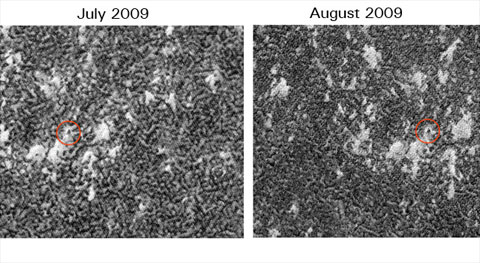
Credit: NASA/JPL-Caltech/University of Arizona As the sun began to reappear on the horizon following the deepest, darkest days of north polar winter on Mars, the HiRISE camera imaged the Phoenix landing site on July 30, 2009, (left image) and in Aug. 22, 2009 (right). |
Robert Pearlman
Editor Posts: 42988
From: Houston, TX
Registered: Nov 1999
|
 posted 01-12-2010 09:59 AM
posted 01-12-2010 09:59 AM
   
NASA release NASA to Check for Unlikely Winter Survival of Mars LanderBeginning Jan. 18, NASA's Mars Odyssey orbiter will listen for possible, though improbable, radio transmissions from the Phoenix Mars Lander, which completed five months of studying an arctic Martian site in November 2008. The solar-powered lander operated two months longer than its three-month prime mission during summer on northern Mars before the seasonal ebb of sunshine ended its work. Since then, Phoenix's landing site has gone through autumn, winter and part of spring. The lander's hardware was not designed to survive the temperature extremes and ice-coating load of an arctic Martian winter. In the extremely unlikely case that Phoenix survived the winter, it is expected to follow instructions programmed on its computer. If systems still operate, once its solar panels generate enough electricity to establish a positive energy balance, the lander would periodically try to communicate with any available Mars relay orbiters in an attempt to reestablish contact with Earth. During each communications attempt, the lander would alternately use each of its two radios and each of its two antennas. Odyssey will pass over the Phoenix landing site approximately 10 times each day during three consecutive days of listening this month and two longer listening campaigns in February and March. "We do not expect Phoenix to have survived, and therefore do not expect to hear from it. However, if Phoenix is transmitting, Odyssey will hear it," said Chad Edwards, chief telecommunications engineer for the Mars Exploration Program at NASA's Jet Propulsion Laboratory, Pasadena, Calif. "We will perform a sufficient number of Odyssey contact attempts that if we don't detect a transmission from Phoenix, we can have a high degree of confidence that the lander is not active." The amount of sunshine at Phoenix's site is currently about the same as when the lander last communicated, on Nov. 2, 2008, with the sun above the horizon about 17 hours each day. The listening attempts will continue until after the sun is above the horizon for the full 24.7 hours of the Martian day at the lander's high-latitude site. During the later attempts in February or March, Odyssey will transmit radio signals that could potentially be heard by Phoenix, as well as passively listening. If Odyssey does hear from Phoenix, the orbiter will attempt to lock onto the signal and gain information about the lander's status. The initial task would be to determine what capabilities Phoenix retains, information that NASA would consider in decisions about any further steps. 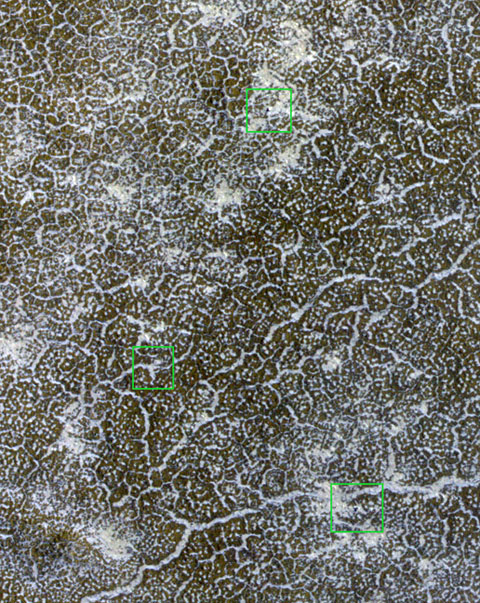
Credit: NASA/JPL-Caltech/University of Arizona NASA's Phoenix Mars Lander, its backshell and its heatshield are visible within this enhanced-color image of the Phoenix landing site taken on Jan. 6, 2010 by the High Resolution Imaging Science Experiment (HiRISE) camera on NASA's Mars Reconnaissance Orbiter. |
Robert Pearlman
Editor Posts: 42988
From: Houston, TX
Registered: Nov 1999
|
 posted 01-22-2010 10:12 AM
posted 01-22-2010 10:12 AM
   
NASA update NASA Orbiter Listening for Phoenix Lander Hears NothingNASA's Mars Odyssey orbiter has completed 11 overflights, listening for the Phoenix Mars Lander on Jan. 19 and 20, without hearing anything from the lander. Nineteen more listening overflights are planned this week, and additional attempts in February and March. The attempts are being made because of the unlikely scenario that Phoenix has survived Martian arctic winter conditions the spacecraft was never designed to withstand. Phoenix landed on Mars on May 25, 2008, and operated successfully about two months longer than its planned three-month mission near the Martian north polar region. |
Robert Pearlman
Editor Posts: 42988
From: Houston, TX
Registered: Nov 1999
|
 posted 02-23-2010 09:35 PM
posted 02-23-2010 09:35 PM
   
Mars Odyssey and Phoenix Mars Lander Missions Status Report No Signal Heard During First Day of Resumed Listening for PhoenixNASA's Mars Odyssey began a second campaign Monday to check on whether the Phoenix Mars Lander has revived itself after the northern Martian winter. The orbiter received no signal from the lander during the first 10 overflights of this campaign. Odyssey will listen for Phoenix during 50 additional overflights, through Feb. 26, during the current campaign. Phoenix landed on Mars on May 25, 2008, and operated successfully in the Martian arctic for about two months longer than its planned three-month mission. Operations ended when waning sunlight left the solar-powered craft with insufficient energy to keep working. The season at the Phoenix landing site is now mid-springtime, with the sun above the horizon for roughly 22 hours each Martian day. That is comparable to the illumination that Phoenix experienced a few weeks after completing its three-month primary mission. Phoenix was not designed to withstand the extremely low temperatures and the ice load of the Martian arctic winter. In the extremely unlikely event that the lander has survived the winter and has achieved a stable energy state, it would operate in a mode where it periodically awakens and transmits a signal to any orbiter in view. A third campaign to check on whether Phoenix has revived itself is scheduled for April 5-9, when the sun will be continuously above the Martian horizon at the Phoenix site. |
Robert Pearlman
Editor Posts: 42988
From: Houston, TX
Registered: Nov 1999
|
 posted 05-20-2010 07:32 AM
posted 05-20-2010 07:32 AM
   
NASA Jet Propulsion Laboratory release Final Attempts to Hear from Mars Phoenix ScheduledFrom May 17 to 21, NASA's Mars Odyssey orbiter will conduct a fourth and final campaign to check on whether the Phoenix Mars Lander has come back to life. During that period, Odyssey will listen for a signal from Phoenix during 61 flights over the lander's site on far-northern Mars. The orbiter detected no transmission from the lander in earlier campaigns totaling 150 overflights in January, February and April. In 2008, Phoenix completed its three-month mission studying Martian ice, soil and atmosphere. The lander worked for five months before reduced sunlight caused energy to become insufficient to keep the lander functioning. The solar-powered robot was not designed to survive through the dark and cold conditions of a Martian arctic winter. However, in case it did, NASA has used Odyssey to listen for the signals that Phoenix would transmit if abundant spring sunshine revived the lander. Northern Mars will experience its maximum-sunshine day, the summer solstice, on May 12 (Eastern Time; May 13, Universal Time), so the sun will be higher in the sky above Phoenix during the fourth listening campaign than during any of the prior ones. Still, expectations of hearing from the lander remain low. "To be thorough, we decided to conduct this final session around the time of the summer solstice, during the best thermal and power conditions for Phoenix," Chad Edwards, chief telecommunications engineer for the Mars Exploration Program at NASA's Jet Propulsion Laboratory, Pasadena, Calif., said. The Phoenix mission is led by Principal Investigator Peter H. Smith of the University of Arizona, Tucson, with project management at JPL and development partnership with Lockheed Martin Space Systems. JPL, a division of the California Institute of Technology in Pasadena, also manages the Odyssey project in an operational partnership with Lockheed Martin. |
Robert Pearlman
Editor Posts: 42988
From: Houston, TX
Registered: Nov 1999
|
 posted 05-25-2010 03:51 AM
posted 05-25-2010 03:51 AM
   
NASA release Phoenix Mars Lander Does Not Phone Home, New Image Shows DamageNASA's Phoenix Mars Lander has ended operations after repeated attempts to contact the spacecraft were unsuccessful. A new image transmitted by NASA's Mars Reconnaissance Orbiter (MRO) shows signs of severe ice damage to the lander's solar panels. "The Phoenix spacecraft succeeded in its investigations and exceeded its planned lifetime," said Fuk Li, manager of the Mars Exploration Program at NASA's Jet Propulsion Laboratory in Pasadena, Calif. "Although its work is finished, analysis of information from Phoenix's science activities will continue for some time to come." 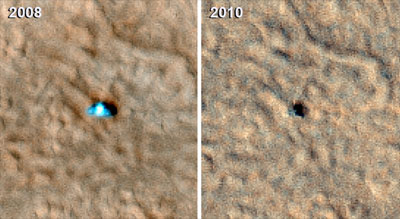
Credit: NASA/JPL-Caltech/University of ArizonaLast week, NASA's Mars Odyssey orbiter flew over the Phoenix landing site 61 times during a final attempt to communicate with the lander. No transmission from the lander was detected. Phoenix also did not communicate during 150 flights in three earlier listening campaigns this year. Earth-based research continues on discoveries Phoenix made during summer conditions at the far-northern site where it landed May 25, 2008. The solar-powered lander completed its three-month mission and kept working until sunlight waned two months later. Phoenix was not designed to survive the dark, cold, icy winter. However, the slim possibility Phoenix survived could not be eliminated without listening for the lander after abundant sunshine returned. The MRO image of Phoenix taken this month by the High Resolution Imaging Science Experiment, or HiRISE, camera on board the spacecraft suggests the lander no longer casts shadows the way it did during its working lifetime. "Before and after images are dramatically different," said Michael Mellon of the University of Colorado in Boulder, a science team member for both Phoenix and HiRISE. "The lander looks smaller, and only a portion of the difference can be explained by accumulation of dust on the lander, which makes its surfaces less distinguishable from surrounding ground." Apparent changes in the shadows cast by the lander are consistent with predictions of how Phoenix could be damaged by harsh winter conditions. It was anticipated that the weight of a carbon-dioxide ice buildup could bend or break the lander's solar panels. Mellon calculated hundreds of pounds of ice probably coated the lander in mid-winter. During its mission, Phoenix confirmed and examined patches of the widespread deposits of underground water ice detected by Odyssey and identified a mineral called calcium carbonate that suggested occasional presence of thawed water. The lander also found soil chemistry with significant implications for life and observed falling snow. The mission's biggest surprise was the discovery of perchlorate, an oxidizing chemical on Earth that is food for some microbes and potentially toxic for others. "We found that the soil above the ice can act like a sponge, with perchlorate scavenging water from the atmosphere and holding on to it," said Peter Smith, Phoenix principal investigator at the University of Arizona in Tucson. "You can have a thin film layer of water capable of being a habitable environment. A micro-world at the scale of grains of soil -- that's where the action is." The perchlorate results are shaping subsequent astrobiology research, as scientists investigate the implications of its antifreeze properties and potential use as an energy source by microbes. Discovery of the ice in the uppermost soil by Odyssey pointed the way for Phoenix. More recently, the MRO detected numerous ice deposits in middle latitudes at greater depth using radar and exposed on the surface by fresh impact craters. "Ice-rich environments are an even bigger part of the planet than we thought," Smith said. "Somewhere in that vast region there are going to be places that are more habitable than others." NASA's MRO reached the planet in 2006 to begin a two-year primary science mission. Its data show Mars had diverse wet environments at many locations for differing durations during the planet's history, and climate-change cycles persist into the present era. The mission has returned more planetary data than all other Mars missions combined. Odyssey has been orbiting Mars since 2001. The mission also has played important roles by supporting the twin Mars rovers Spirit and Opportunity. The Phoenix mission was led by Smith at the University of Arizona, with project management at JPL and development partnership at Lockheed Martin in Denver. The University of Arizona operates the HiRISE camera, which was built by Ball Aerospace and Technologies Corp., in Boulder. Mars missions are managed by JPL for NASA's Mars Exploration Program at NASA Headquarters in Washington. |
Robert Pearlman
Editor Posts: 42988
From: Houston, TX
Registered: Nov 1999
|
 posted 02-20-2018 05:03 PM
posted 02-20-2018 05:03 PM
   
NASA release Nearly a Decade After Mars Phoenix Landed, Another LookA recent view from Mars orbit of the site where NASA's Phoenix Mars mission landed on far-northern Mars nearly a decade ago shows that dust has covered some marks of the landing.  The Phoenix lander itself, plus its back shell and parachute, are still visible in the image taken Dec. 21, 2017, by the High Resolution Imaging Science Experiment (HiRISE) camera on NASA's Mars Reconnaissance Orbiter. But an animated-blink comparison with an image from about two months after the May 25, 2008, landing shows that patches of ground that had been darkened by removal of dust during landing events have become coated with dust again. In August 2008, Phoenix completed its three-month mission studying Martian ice, soil and atmosphere. The lander worked for two additional months before reduced sunlight caused energy to become insufficient to keep the lander functioning. The solar-powered robot was not designed to survive through the dark and cold conditions of a Martian arctic winter. | |
Contact Us | The Source for Space History & Artifacts
Copyright 2020 collectSPACE.com All rights reserved.

Ultimate Bulletin Board 5.47a
|
|

|
 advertisement advertisement

|



















